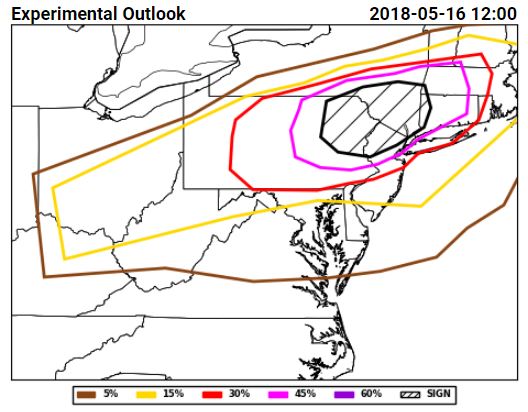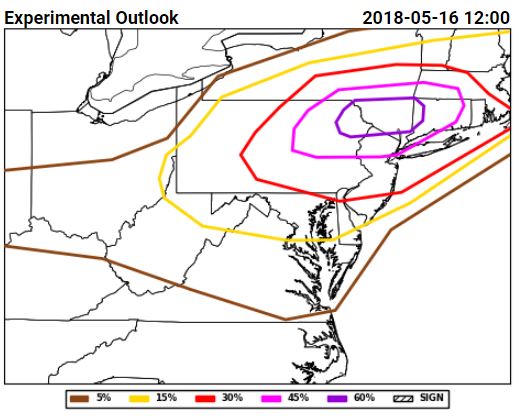One of the advantages to having forecasters from the Storm Prediction Center (SPC) working on both the Innovation Desk and the Severe Hazards Desk is that they have experience with issuing outlooks, and how the public reacts to those outlooks. Thus, we can explore the nuance of forecast issuance better than if we were operating without the SPC forecasters. An example of this dynamic occurred on Tuesday this week, with the well-forecast line of storms that moved through the northeastern United States, bringing many reports of wind damage, injuries, and even fatalities. The experimental forecasts issued by both the Severe Hazards Desk and the Innovation Desks were the equivalent of a categorical Moderate Risk from the SPC, which can be triggered by either a 45% forecast of wind with significant wind gusts or a 60% forecast of wind without the significant wind gusts:

On the Innovation Desk side, there was a lot of debate about which type of moderate risk to issue. A categorical high risk was also considered, by debating whether or not to issue a 60% coverage contour with significant severe. Although we thought that there would be pretty high coverage of severe wind reports, the low-level shear and the strong low-level flow that would typically warrant a high-risk scenario were missing on Tuesday. High risk issuance for wind from the SPC is rare (as are high risks in general) and typically reserved for derecho-type events. The last wind-driven high risk was issued by the SPC on 3 June 2014 across Nebraska. Thus, an aggressive moderate was the message the Innovation Desk tried to pursue, with a 45% area and an area of significant severe (wind gusts in this case, although the Innovation Desk considers all types of severe convective weather in issuing its probabilities):

The Severe Hazards Desk issued a moderate that emphasized the high coverage potential of the event, going with a 60% contour with no significant wind highlighted:

Both of these outlooks indicated that the meteorological conditions were unusually favorable for a wind event, with strong mid-level flow and excellent lapse rates for the northeast. However, maintaining the equivalent of a moderate categorical risk communicated that this system, while dangerous and powerful, would not rise to the level of some of the most infamous derechos of years past. In meteorology, as in many things, communication is key.
